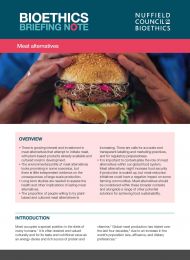Meat alternatives
Policy Briefing
Published 08/01/2020

Market trends
New products have helped boost the plant-based meat alternatives sector. In the European market, meat substitutes have seen a growth rate of 450% between 2013 and 2017, capturing 1% of the total meat market. Global investments in the plant-based meat industry exceeded US$1 billion between 2017-2018. Investors include venture capitalists, as well as those in the traditional meat industry, such as Tyson Foods, America’s largest meat producer, which has also launched its own plant-based products.* Recent products that have been introduced into the market include the Beyond Burger, which is sold in over 25,000 food outlets worldwide and can be found in the meat section of some UK supermarkets, and the Impossible Burger, which is served in more than 10,000 food outlets in the US. In October 2019, it was reported that Impossible Foods has applied for authorisation of the use of an ingredient, soy leghemoglobin, which would enable its products to be sold in the EU.
*As of the end of 2019, virtually every global meat industry leader has either announced or already commercialised launched products in this category, see, GFI (24 October 2019) Plant-based meat is transforming thefood industry from the inside.
Methods of production
New plant-based meat alternatives are using novel ingredients and innovative processes to create products with a higher degree of meat mimicry. Beyond Burger’s key ingredients are pea protein isolate, canola oil and refined coconut oil. The Impossible Burger uses soy protein isolate and soy leghemoglobin, which contains ‘heme’, an iron-rich molecule. Impossible’s leghemoglobin is manufactured by genetically engineered yeast and gives the burger the colour, aroma, and flavour of meat.
Creating realistic cuts of meat or fish, rather than processed products such as burgers, remains a challenge. However, 3D-printing techniques to produce plant-based meat alternatives are being developed. Using a new scaffolding technique, meat-alternative products can be 3D-printed from vegetable proteins to resemble the fibrous texture of meat.
Implications for the environment
Estimates of the environmental impact and sustainability of large-scale production of plant-based meat alternatives vary according to the assumptions of different lifecycle assessments, and further independent evidence is needed. Lifecyle assessments comparing plant-based meat alternative products to conventional meat products find that plant-based meat uses 72-99% less water, 47-99% less land, emits 30-90% fewer greenhouse gases and causes 51-91% less aquatic nutrient pollution.
Other research, however, suggests that some plant-based meat alternatives can produce similar levels of emissions as some unprocessed or minimally processed animal-sourced products.36 Environmental sustainability might be limited by the energy required for protein processing and transformation of raw materials. Plant ingredients can also pose environmental risks. Intensive crop monoculture can drive deforestation and climate change, as with the example of soy production in South America.
Implications for health
In contrast to most meat products, the Beyond Burger and Impossible Burger provide fibre and contain no cholesterol. However, these and similar products are highly processed and incorporate purified plant protein rather than whole foods, contain similar levels of calories and saturated fat as beef burgers, and have much higher levels of sodium and iron. Nutrition experts have cautioned against extrapolating the health benefits of eating minimally processed fruits, vegetables, whole grains and nuts to plant-based meat alternatives.*
The health effects of soy leghemoglobin and other ingredients not previously consumed by humans have not been established. There are calls for rigorous, independent studies to assess the overall long-term health implications of plant-based meat alternatives, so that people can make informed food choices based on considerations of health, as well as animal welfare and environmental impact.
* For a nutritional comparison of meat and meat alternatives, see WEF (2019) Meat: the future series - alternative proteins.

Share